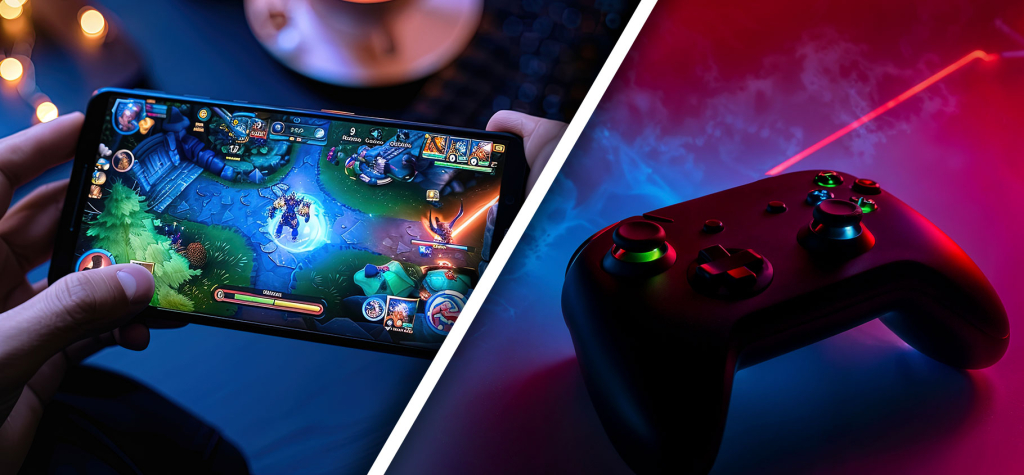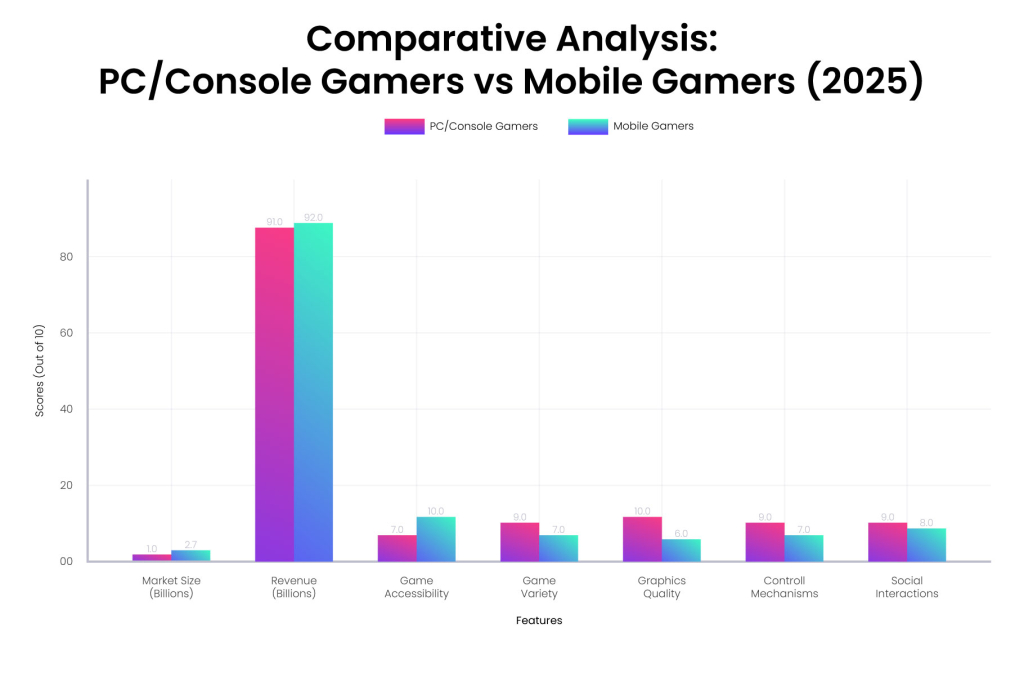New to gaming? You may be thinking about whether to begin with mobile or console gaming. Both alternatives provide unique benefits: mobile games allow you to play anywhere and at any time, whereas consoles provide rich, engrossing experiences. Let’s explore the differences between mobile gaming vs console gaming, including their perks and limitations, so you can choose the best fit for your gaming experience.
Starting your gaming journey should be thrilling, not overwhelming. With mobile games evolving and consoles showcasing incredible graphics, each platform offers unique experiences. Whether you want to enjoy short gaming bursts during your lunch hour or immerse yourself in breathtaking virtual realms, knowing the differences between mobile and console gaming is essential for choosing the right fit. This guide will assist you in making a well-informed decision that aligns with your lifestyle and gaming aspirations.
Remember Snake on those old Nokia phones? That’s where mobile gaming began in the late ’90s. Things really took off when games like Angry Birds and Candy Crush showed what phones could really do. Fast forward to now, and mobile gaming has become huge, thanks to easy-to-access app stores and games you can start playing for free.
Here’s how mobile gaming evolved:
Today, mobile games reach billions of players worldwide, making gaming more accessible than ever.
Console gaming kicked off in the 1970s with the Magnavox Odyssey. The real magic happened in the 1980s when Nintendo (NES) and Sega Genesis arrived, bringing better graphics and stories that captured our imagination.
Big moments in console gaming:
With powerhouses like the PlayStation 5 and Xbox Series X, console gaming continues to deliver the kind of immersive experiences that make players’ jaws drop. For those exploring options, a gaming consoles comparison can help highlight the strengths of each system and guide you to the perfect choice for your gaming needs.
The gaming landscape in 2025 presents a dynamic picture of growth and evolution across both mobile and console platforms, offering diverse opportunities for businesses in the gaming industry.
The input methods for gaming represent a significant distinction between mobile and console platforms. Mobile games typically use touchscreens, on-screen buttons, and device motion controls, which are designed for straightforward and user-friendly interaction on mobile devices. This control scheme makes mobile games easily approachable for newcomers or those seeking quick gaming sessions. The trade-off, however, is that these digital controls often can’t match the accuracy and physical response of traditional controllers, which becomes particularly apparent in genres requiring precise input, like first-person shooters and fighting games.

When comparing PC gaming vs console gaming, it’s clear that dedicated controllers offer superior accuracy and tactile feedback. Game console comparison highlights the value of traditional controllers featuring joysticks, buttons, and triggers that deliver a more engaging and responsive gaming experience. These peripherals are built with comfort in mind and support sophisticated gameplay mechanics, enabling better control over character movement and game actions. The accuracy these controllers provide makes console gaming particularly well-suited for genres such as competitive shooters, sports titles, and action-adventure games, where precise timing and detailed control inputs are essential for an enjoyable experience.
Key Differences:
Mobile gaming primarily revolves around casual and hyper-casual genres designed for brief, entertaining play sessions. The mobile platform excels with puzzle games, arcade-style titles, and battle royales that feature simple-to-grasp mechanics and swift gameplay. These games are typically structured for brief, repeatable sessions, making them ideal for gaming while moving about.

On the other hand, console gaming, as shown in a gaming consoles comparison, generally centers on delivering more sophisticated and comprehensive gaming experiences. Many console titles are high-budget AAA releases featuring detailed storylines, vast environments, and refined gameplay systems. Console platforms commonly host genres like action-adventure games, RPGs, and realistic racing games, as their hardware can support the processing requirements of these immersive, large-scale experiences. This results in console games requiring more extensive development cycles and investment, making them better suited for players seeking more profound, more extended gaming experiences.
Key Differences:
The processing capabilities between mobile and console platforms differ substantially, largely stemming from their core functions. Mobile devices serve multiple purposes, functioning as phones, communication tools, and entertainment centers in one package. Though mobile gaming technology has advanced considerably in recent years, smartphones still face constraints in graphics capability, processing power, and storage capacity when compared to gaming-specific consoles.
Gaming consoles like PlayStation, Xbox, and Nintendo Switch are built exclusively for gaming purposes, delivering significantly higher performance levels. These systems come equipped with robust processors and advanced graphics cards that enable more intricate visuals, consistent frame rates, and expansive gaming environments. Gaming consoles comparison shows how console gaming leverages this specialized hardware, allowing players to experience visually impressive and resource-intensive games without significant technical limitations. This performance gap establishes consoles as the preferred platform for gamers seeking premium experiences with sophisticated graphics and advanced physics engines.
Key Differences:
Mobile gaming’s standout feature is its convenience on the go. Users can enjoy mobile games in any setting – during travel, in queues, or at home. The only requirement is a smartphone or tablet, which most individuals already possess. This accessibility enables players to access their game library without being restricted to a particular location or gaming setup.

On the other hand, console systems, as highlighted in console comparison discussions, are generally stationary units requiring connection to a display, gaming controllers, and additional accessories. Although some consoles like the Nintendo Switch provide portable options, they face restrictions in terms of battery duration and visual performance compared to their fixed counterparts. Even with portable models available, console systems don’t match the on-the-go gaming convenience mobile devices offer.
Key Differences:
Mobile gaming typically employs a free-to-play strategy with optional in-game purchases as its revenue source. Players can download and start games without cost, while developers earn through purchases of virtual items, cosmetics, or advancement accelerators. This approach has proven highly effective, especially in casual gaming, by eliminating initial cost barriers for potential players. However, the dependence on microtransactions can sometimes create an unbalanced “pay-to-win” situation, where spending money provides competitive advantages.

Console gaming traditionally uses a straightforward purchase model or subscription-based services that grant access to game collections. This provides players with clear understanding of their expenses, avoiding potential issues with excessive microtransactions. Additionally, platforms offer services such as Xbox Game Pass or PlayStation Plus, providing monthly subscriptions for diverse game libraries. This model offers more predictability for both players and developers, generating income through initial sales or regular subscriptions rather than in-game purchases.
Key Differences:
Console gaming’s notable strength lies in platform-specific games available only on certain systems. PlayStation users exclusively access titles like The Last of Us and God of War, while Xbox owners specifically enjoy series like Halo and Forza Horizon. These platform-exclusive releases serve as powerful marketing tools for the consoles, influencing consumer choice based on desired game libraries.
Mobile gaming, alternatively, typically features broader availability. Most well-known mobile games can be found on both Android and iOS platforms, reaching a wider user base. Though some exclusives exist, particularly with certain publishers or brands, mobile game developers generally aim to maximize accessibility by releasing across both major mobile platforms.
Key Differences:
Mobile and console gaming show distinct differences in how players interact with their games. Mobile games are typically structured for brief, intermittent play sessions, suiting players who have limited pockets of free time throughout their day. Whether playing a quick puzzle round or jumping into a battle royale match, mobile gaming serves those seeking short bursts of entertainment.
Console gaming, conversely, is designed for more extensive, absorbing play periods. Players tend to engage in longer gaming sessions, particularly with high-budget titles featuring detailed narratives or multiplayer components. This results in console gaming demanding greater time investment and attention, with users typically dedicating extended periods to fully experience their games.
Key Differences:
| Aspect | Mobile Gaming | Console Gaming |
| Control Mechanism | Pro: Intuitive touch controls, easy to learn | Pro: Precision controls with physical gamepads |
| Con: Less precise controls, limited tactile feedback | Con: Requires learning controller layouts, less intuitive for beginners | |
| Game Genres | Pro: Casual, quick-to-play games | Pro: Complex, immersive AAA titles and detailed RPGs |
| Con: Limited to less complex games, shallow gameplay | Con: Takes longer to learn, more intense for casual players | |
| Hardware | Pro: Highly portable, multi-functional devices | Pro: High-performance hardware for better graphics |
| Con: Limited processing power, lower graphics | Con: Less portable, requires dedicated space | |
| Portability | Pro: Play anywhere, no setup required | Pro: Handheld options (e.g., Nintendo Switch) |
| Con: Shorter battery life, smaller screens | Con: Requires TV/monitor and stationary setup | |
| Monetization | Pro: Free-to-play, microtransactions for free games | Pro: One-time purchases, subscription services (e.g., Xbox Game Pass) |
| Con: Frequent microtransactions, “pay-to-win” issues | Con: Higher upfront costs for games and consoles | |
| Exclusivity | Pro: Wide availability across devices | Pro: Exclusive titles that draw players to specific consoles |
| Con: Fewer exclusive games | Con: Exclusive games are locked to certain platforms | |
| User Engagement | Pro: Quick gaming sessions, casual play | Pro: Deep, immersive gaming for longer sessions |
| Con: Limited in-depth experiences, less immersive | Con: Requires more time commitment, can be overwhelming for casual players | |
| Game Development | Pro: Easier and cheaper to develop for mobile | Pro: High-quality graphics and complex mechanics possible |
| Con: Limited by mobile hardware and screen size | Con: Requires more resources, development time, and budget |
Choose Mobile Gaming When:
Choose Console Gaming When:
In comparing platforms and trends, especially in the 3D gaming consoles market, it’s essential to understand the nuances of the gaming consoles comparison. From the simplicity of mobile gaming to the complexity and dedication required for console gaming, players’ preferences are shaped by their individual gaming needs. When considering a game console comparison, it’s clear that both mobile and console gaming offer distinct advantages depending on the gaming experience you’re looking for.
At Juego Studios, we understand the intricacies of both mobile and console game development. Whether you’re creating a casual mobile app or a deeply immersive console game, our experienced team of developers and designers can bring your vision to life. With expertise in creating engaging gameplay, stunning graphics, and seamless user experiences, we’re the perfect partner for your next project. Let us help you navigate the gaming landscape and turn your ideas into successful gaming experiences.
Both mobile and console gaming offer unique experiences suited to different preferences, needs, and lifestyles. Mobile gaming provides convenience, accessibility, and a wide range of casual games, making it ideal for short sessions and quick entertainment. On the other hand, console gaming delivers immersive, high-quality experiences perfect for gamers seeking deeper engagement and extended playtime. By understanding the key differences, pros and cons, and when to choose each platform, you can make an informed decision that aligns with your gaming style.
While mobile games have made significant strides in quality, particularly with advancements in hardware and graphics capabilities, console games still generally lead in terms of graphical fidelity and overall performance. Mobile devices are now equipped with powerful processors and GPUs that allow for impressive visuals and complex gameplay; however, they often cannot match the high-end graphics and immersive experiences provided by dedicated gaming consoles like the PlayStation 5 or Xbox Series X.
Many mobile games are now designed to deliver AAA-quality experiences, but the majority of high-budget titles still favor consoles due to their superior hardware capabilities and optimization for complex game mechanics.
Consoles excel in delivering immersive, high-quality gaming experiences, particularly in the following genres:
These genres leverage the advanced graphics, processing power, and controller precision that consoles provide, creating a more engaging experience compared to mobile platforms.
The development timelines for mobile and console games differ significantly:
Ultimately, the choice between console and mobile gaming depends on individual preferences and gaming needs.
Yes, mobile gaming is currently larger than console gaming in terms of revenue generation. As of late 2024, mobile games have surpassed the combined revenue of both console and PC games, reflecting a significant shift in consumer preferences toward portable and accessible gaming options. This trend is expected to continue as smartphones become more powerful and accessible to a broader audience. The growth of the mobile gaming market is projected to maintain a steady increase, further solidifying its dominance over traditional console gaming.
Mobile gaming is poised to play a crucial role in the future of the gaming industry due to its rapid growth and increasing technological capabilities. As smartphones evolve with better graphics and processing power, mobile games are becoming more sophisticated, approaching the quality of console games. The convenience of mobile platforms allows for greater accessibility, attracting diverse demographics that may not traditionally engage with console or PC gaming.
Additionally, the rise of cloud gaming services enhances the appeal of mobile devices as platforms for playing high-quality games without the need for dedicated hardware. Therefore, while consoles will continue to have their place, mobile gaming is likely to be a significant driving force in shaping the future landscape of gaming.